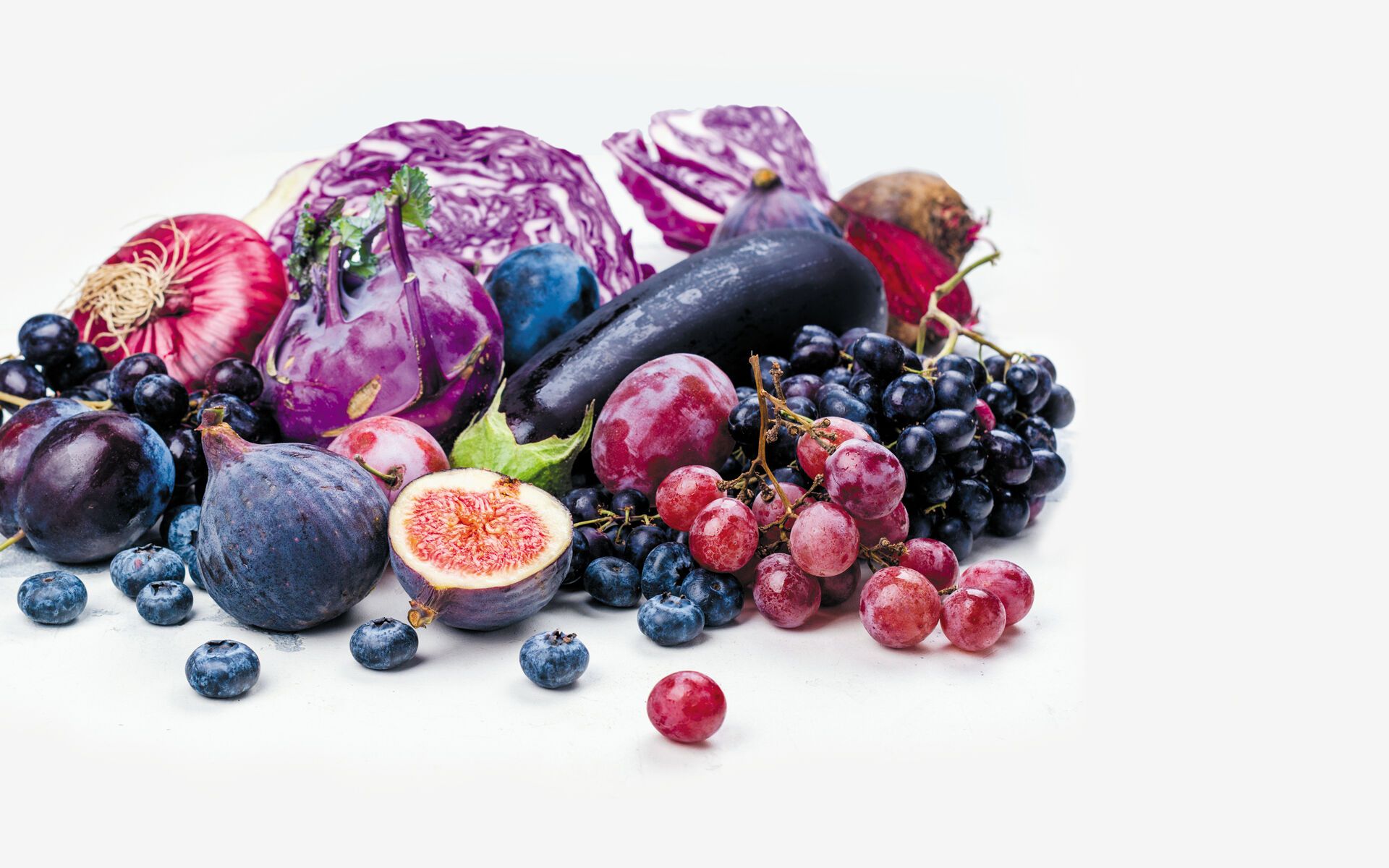Anthocyanins and Their Role in Our Colorful World

In This Article
-
How do colors emerge? How do plants—whose only contact is dark soil, colorless air, and water—attain their colors?
-
Anthocyanins are the pigments that give color to many fruits and vegetables such as raspberries, blackberries, sour cherries, damson plums, purple carrots, red cabbages, beets, eggplants, red radishes, pomegranates, tree strawberries, black and red grapes, and many more.
-
While we watch the colorful flowers and fruits spread before us without knowing these details, the pigment molecules, dispatched like officers or soldiers in the background, repeat the same chemical processes every year, fulfilling their duties in full submission.
When the first color TV entered in our lives in the 1980s, it made a huge difference. It was only a few of our neighbors who had one, and we always wanted to go to him to watch cartoons in color, which was much more fun than in black-and-white. Younger generations who are reading this article were directly introduced to color television, so they probably could not fully realize its value.
The same is perhaps true of nature. We have come to know the nature, trees, flowers, fruits, vegetables, rocks, and animals all in their own beautiful colors – that’s how we have observed them since we were born, so sometimes we are not aware of their value. Can we imagine oranges, apples, strawberries, tomatoes, eggplants, daisies, magnolias, tulips, and roses without color? We cannot describe colorlessness, so we use “black” and “white” to express the contrast.
Colors of plants
Part of the earth is covered with snow in winter. Almost black and white during this period, our world becomes colorful with spring’s arrival and reminds us of the resurrection after death. In different seasons, almost every shade of color parades before our eyes: the white, yellow, red, and pink of roses, tulips, carnations, apples, and plums. Yet, how do these colors emerge? How do plants—whose only contact is dark soil and colorless air and water—attain their colors?
As with inanimate objects, the color reflected by plants depends on their pigment [1] molecule. Usually yellow and red in color, there are three types of carotenoids (biological pigments): carotene, lycopene, and xanthophylls. The green color in several fruits and vegetables come from chlorophylls. Flavonoids are substances that give plants their white, light-yellow color. Anthocyanins are color pigments that range from pink to purple. Anthoxanthin are pigments that give colors like white and cream. Tannins are substances that turn red and solidify when heated with acid.
The correlation between colors and pollination
Plants are an indispensable part of the food chain and nature’s balance. Pollination [2] is essential for the reproduction and growth of flowering plants. Although the wind and some animals are instrumental in pollination, this task is largely assigned to bees and similar small insects. The colors of flowers also matter to attract the attention of bees. Bees fulfill a vital role in the pollination and subsequent fertilization of flowers, while there are also flowers purposely not pollinated by bees. For example, since bees cannot distinguish the color red, they cannot pollinate flowers having this color. Some red plants such as laurel, red carnations, and wild flax, which do not have other colors, are pollinated by other insects. Since the nectar of these plants is located deeper in their bodies, insects such as butterflies with long mouthparts like proboscis have the duty to reach for them. As in this example, all living beings have been given certain skills and potentials in order to do certain tasks so the ecosystem and the symbiosis between plants and animals can be maintained.
Anthocyanins
Anthocyanins are the largest group of pigments, and they color plants on the red, blue, and purple spectrum. Anthocyanins are the pigments that make several fruits and vegetables such as raspberries, blackberries, sour cherries, damson plums, purple carrots, red cabbages, beets, eggplants, red radishes, pomegranates, tree strawberries, black and red grapes, and many more.
Anthocyanins have properties other than color. These water-soluble substances are also highly-potent antioxidants which prevent the oxidation of vital molecules in the cell and the oxidation of the cell itself. Studies have even shown the inhibitory effect anthocyanins have on cell growth in some types of cancer. Studies conducted at the University of Michigan have revealed the positive effect these substances have on relieving muscle pain, lowering sugar levels, and reducing fat in the liver.
Anthocyanins obtained from some fruits and flowers are also used as colorants in various foods.
Anthocyanins absorb visible light with wavelengths between 400-800 nm, and the reflected part is seen as color. There are over 600 anthocyanins known today. Flowers can also accumulate a mixture of anthocyanin types, resulting in numerous color variations. Thus, these pigments function as masterpieces of art in hundreds of thousands of different shades of red, blue, and purple.
Changes in the molecular structure of the cited substances is what lies behind plants’ having thousands of different colors and shades. With the differentiation of the R1, R2, and R3 groups shown in the figure, anthocyanin absorbs different ranges of light and gives the plant different colors. These molecules’ structures change at the primary, secondary, and tertiary levels. When the groups indicated by (R) in the figure are replaced by hydrogen (H), hydroxide (OH), or alkyl (R), the color changes. If a green leaf turns yellow at first and red later, it means these chemical changes are taking place in its molecules.
While we watch the colorful flowers and fruits spread before us without knowing these details, the pigment molecules, dispatched like officers or soldiers in the background, repeat the same chemical processes every year, fulfilling their duties in full submission. Hundreds of publications on anthocyanins attempt to both reveal the intricacies of this system and illuminate the functions of these molecules within the cell.

Color vision
It has been found that a healthy human eye can distinguish approximately one million colors. How is this possible?
After passing through the cornea, pupil, and lens of the eye, the incoming light falls onto the retina, the wall of the eye's posterior dark chamber. Special cells here, resembling very complex electronic circuits, convert light into electrical signals and transmit them to the brain. This is an immensely complex system in which the light energy is converted into electrical energy of certain intensities, and as a result an image is formed in the brain. Photoreceptor (light receptor) cells in the retina are of two types: cone- and rod-shaped. Cone cells are designed for color vision, while rod cells are designed for black-and-white vision. The task of these two types of cells is to convert the light falling on them into electrical signals. Humans have three types of cone cells (blue, green, red) that react differently to various wavelengths of light. Each cell has a different sensitivity to light. The wavelength of light to which blue cone cells are most sensitive is about 430 nanometers, green cone cells about 530 nm and red cone cells about 560 nm.
Our eyes were not created with the capacity to perceive all the wavelengths that exist as colors. Therefore, animals can see certain color wavelengths we cannot. Wavelengths such as infrared and ultraviolet can be seen as colors by some animals. For example, one study found four types of cone cells in the eye of the broad-tailed hummingbird (Selasphorus platycercus) [3]. This hummingbird also appears to detect ultraviolet wavelengths invisible to humans. Scientists think this may play a vital role in their feeding and predator avoidance behavior.
The wonderful harmony of colors we see on earth and in the sky soothes our souls and gives us peace.
“And whatsoever He has created for you on earth of varying colors (and diverse forms and qualities): surely in that is a sign for people who reflect and are mindful.” (The Qur’an, 16:13)
Notes
- Colorant organic or inorganic molecule.
- Pollination is the process by which pollen produced in the male organ of the plant is transported to the apex of the female organ on various occasions. Mary Caswell Stoddard et al., “Wild hummingbirds discriminate nonspectral colors”, PNAS, June 15, 2020117 (26), 15112–15122, www.pnas.org/content/early/2020/06/09/1919377117









